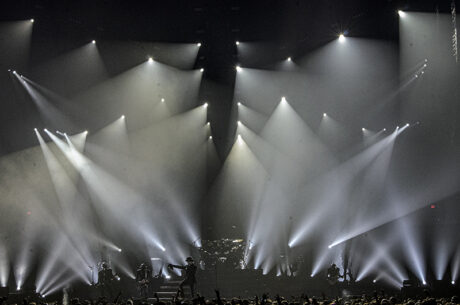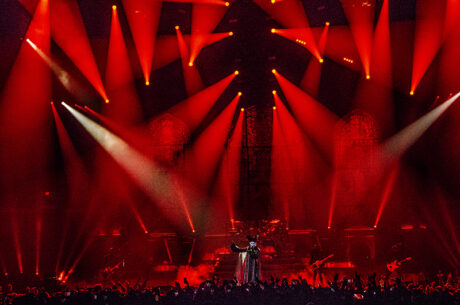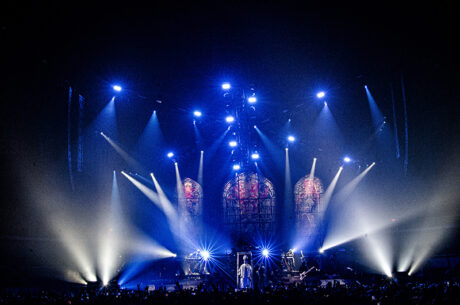
The Swedish rock band Ghost recently wrapped up the third, North American leg of its Imperatour tour for which Brazilian-based Lighting Designer, Erich Bertti—who has been with the Ghost family since 2018—was back designing along with the band’s lead singer Tobias Forge. Senior Account Manager, Steven “Creech” Anderson and Madison, TN-based Premier Global Production (PGP) also were once again supporting Bertti and Ghost, providing lighting, rigging, truss and crew. Bertti and Anderson filled PLSN in on the design and their working relationship for Ghost’s tour.
Talk a little bit about how you worked with Ghost to evoke visually what he wanted to bring to the audience.
Bertti: Tobias, Ghost founder and leader, is very specific about his vision. He considers every detail you can imagine, from structural to artistically to make sure nothing goes off from what he imagined as the final result. He brings a lot of references from vintage cinema, horror movies, global architecture and old school rock and roll.
First thing we discussed was how I visualized Ghost as a “theater-rock” show over the punk-rock look they had at the time. I felt from the start that the whole storytelling behind the history of the band and the clergy should be represented with the lights, props, set and all. I immediately felt that we needed a more dramatic performance from the lights. Shadow plays, back and side lights creating depth and highlighting details from the costumes and such. I saw it more like a musical than a concert to be honest. We agreed upon it and that ended up being it: a show with an intro, a build up on the songs, costume changes, interactions with the audience, intermission and a grand finale. We all refer to it as a spectacle and honestly I feel that is the word that suits best to describe Ghost’s performance.
On the current tour, coming back from a pandemic still, we have a much more ‘straight forward’ show: a lot of banger songs, a shorter set to also be able to have other opening and support acts, and a rig that is a statement by itself. The elements of old are still the backbone of the show but we managed to hit harder than a musical keeping things more dramatic than a rock gig. I keep trying to be true to my saying always—better than no one, worse than no one, different from everyone.
How do you structure your lighting design so that it pairs well with Ghost’s music?
I always try to build up with each song and also throughout the setlist. Intros and verses are calmer and more about the performers and set, when choruses hit, lights make their mark highlighting specific bits and creating a synergy with the song. It’s like a rollercoaster ride in my mind, people should be excited for the choruses, to sing along and also to see the rig behave as their emotions for the song, then calm down a little to repeat the process. As the set progresses lights also get busier and more participant.
A thing that me and Tobias agree on a lot is to keep the audience entertained and guessing from the first song until the last. We’re keeping fixtures hidden for a specific song, features within fixtures unused until certain parts, and we try to not use a “gag” twice during the show. I love the ‘Wow, where is that coming from?’ or ‘what light is that?!’ reaction.
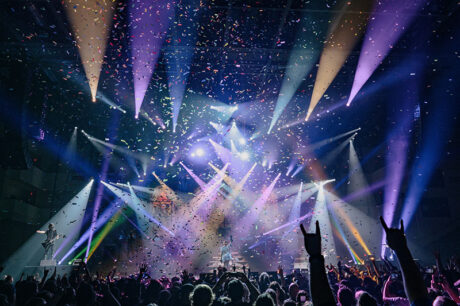
What were some of the key solutions in your design for this recent tour?
I see my rig as an art installation. It is such a big star shaped truss that you simply can’t “not see it” once you arrive at the venue. And the art part is because people react differently to it; some say a starship, some say an alien figure, some say a giant chandelier (because it complements the church windows backdrop). Thing is as soon as something as simple as blinders along the lines go on you see it differently, and that keeps happening throughout the show with different positions and fixture usage. Tobias mentioned that he really loved the way that I played with the lights on this one and that this may be his favorite rig so far: ‘I love to look at something that is foreign and surprising on so many different levels’ he said once.
I always wanted to do a structural statement, a massive piece of truss that could take all the space on the roof and act almost like a living organism on top of a band performing; reacting to the notes as a member of the band itself. And that’s the whole point of it. Since Ghost doesn’t have any LED walls I take a sweet approach on darkness and the generous use of it. It’s amazing how you can create profound impact with just one light on a hundred fixture rig. I simply love it. You can see from the pictures of the show how versatile the rig gets and this is the biggest achievement of this design for me.
On the practical side of designing my number one concern when drafting is always to create a crew-friendly plot. The rig needs to go in and out fast because the crew’s going to grind every day, mostly doing back-to-back shows. You can’t sacrifice the crew, that’s a golden rule for me. Second concern is programming; it can’t be a boring rig. I need to use it in as many different ways as I can, for example in one song I will only use my washes and then I only use the spots in the chorus. For the next song, I don’t use the washes at all, and I play with the beams on the floor and stuff like that. I only use all the fixtures in the last song, which is something that makes me really happy. And then I finished the concert with just one light. It’s a pretty cool move in my opinion and it’s the way I build my own narrative with the lights.
What were some of your main choices
of gear?
Martin MAC Performances. I was looking for a spot fixture because I was tired of having beams or hybrids everywhere. I was looking for a big fixture that had a good output and I was very happy with the Performances, especially because they’re LED. I’m very tired now of the [discharge] bulbs because they keep getting different color temperatures throughout the tour. Also [Clapypaky] B-EYE K20s; even though they’re old, they still have the best macros out there in my opinion. I don’t even care to use the full pixel mode, I only use the normal shapes mode and it makes the show really interesting when I have them. I have maybe five songs where I use macros like the rings and the crosses and others; they are exactly how I want my rig to behave: different. I used Robe LED Beam 150s in clusters of four to give that old school PAR look. They’re amazing. They really blew my mind because I wasn’t expecting that much of an output from them. They’re very narrow when they’re closed zoom, and I really like that. Then I had 16 Robe BMFLs as followspots paired with four Robe RoboSpot stations. On the floor are Martin Axioms to create the general ambience, they do silhouettes and sometimes effects to build up the choruses. I like them as a hybrid fixture. I back light the backdrop windows with SGM P10s, and I have some front uplights from the floor and downlights from SGM P5s from above. P5s also uplight the band from the front.
In conclusion, what do you hope people notice about your design?
I think Ghost is exactly what the industry is lacking at the moment in my perspective. I feel like there’s a lot of music that sounds the same, that follows a recipe. Also, there’s a lot of visual elements on shows going out that are very similar. Ghost is not that. You can come in and after the show you can tell me, ‘I didn’t like it. It’s not for me.’ And that’s fine, but I think that the one thing that you would never say is that it was boring, or it was more of the same. I think you will always be like: ‘Wow, that was interesting.’ It can be interesting good, or it can be interesting bad; but that’s mission accomplished on my behalf. That’s what I wanted. As I mentioned before—better than no one, worse than no one, different from everyone..
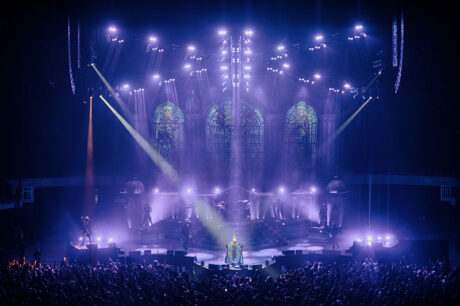
A Good Working Relationship
LD Erich Bertti on working with Premier Global Production:
I got to know PGP on the Metallica run when Ghost was the opener. I was hanging with [Metallica Lighting Designer] Rob Koenig, who’s one of my mentors in a sense; a big friend. Rob and I were talking about the US run that was going to happen. In Brazil, my uncle was the founder of one of the biggest lighting rental companies [LPL]. That’s actually where I started and I worked at that company for 11 years, so I know how it is to be the rental company guy. Creech came down to the Metallica tour and we got talking about all sorts of stuff. I immediately realized that Creech and PGP have a very similar approach to the business as we have here in Brazil. From day one when they came in, we had that security, that safety, that I could pick up the phone with Creech, or [PM] Geddy and say, ‘look, this is not right, we need to make it right’. And they would.
There’s no way you’re going to have a perfect tour. It’s never that way. You always have some things that you deal with, and so to be able to call the guys at PGP and talk to them and have a good relationship with people who know me, and I know them is important. With PGP, you’re not just another tour. That makes a lot of difference, in my book at least. So, it has always been great. The guys on the crew were great and they were grinding, it’s never an easy task. Any problems were always tackled by the crew, by PGP, and always solved. I’m very happy and I am looking forward to them supporting us next year.
PGP are very good partners in this mad house that is touring.
Steven “Creech” Anderson,
PGP Senior Account Manager, on working with Bertti and Ghost:
We had worked on Ghost before and so Erich was familiar with our company, and I think he felt comfortable. The production manager, Mickey Mulcahy, actually lives here in Nashville, so it was easy for him to be able to come over and see the progress of the rig as it was being built. We were able to hang the lighting system in our rehearsal room here and let Erich come in and just double check what he had going on with the programming.
I would put our customer service above and beyond everybody else. I know we brought a great crew and we’ve done really well helping people achieve their goals on this tour. Carving around a lighting spec sheet in order to fit it into someone’s budget—we’re really good at that. At PGP we have a good inventory and our project manager, Anthony “Geddy” Kordyjaka, figures out an easy way to work with the tour structure and how to mechanically mount things. So those are some of the things that we brought to the table for these guys on the Ghost tour. The big one was fitting into their budget and helping them figure out how to get where they needed to be in.
I have to say that Erich is one of the best lighting designers I’ve ever worked with, and I’ve worked with a lot of them. He’s just easy-going, and he knows what he wants to get. I’ll tell you what, he can make a lighting system dance like I’ve never seen anybody do before.
Production Team
- Lighting Company: Premiere Global Production/Rep. Steven “Creech” Anderson
- Lighting Designer and Director: Erich Bertti
- Tour Manager: MaryJo Spillane
- Production Manager: Mickey Mulcahy
- Production Assistant: Aimee Landi
- Rigger: Aaron Lloyd
- Stage Manager: Kevin Kaufman
- Lighting Crew Chief: Ryan Anderson
- Lighting Crew: Jesse Figueroa, Evan Brittain, Pedro Pradenas, Scott Walsh, Chris Edrington
Gear
Lighting
- 1 MA Lighting grandMA3 full-size Console
- 1 MA Lighting grandMA3 light Console
- 24 Martin MAC Ultra Performance
- 40 Martin Axiom
- 37 Claypaky BEYE K20
- 24 GLP JDC1 Hybrid Strobe
- 64 Robe LED Beam 150
- 16 Robe BMFL Spot
- 4 Robe RoboSpot Control Systems
- 30 GLP impression X4
- 24 Prolights ArenaCob 4FC
- 10 SGM P10 Strobe w/ 43˚ lens
- 12 Philips Color Kinetics ColorBlast 12”
- 19 Antari Geyser RGBA Machine
- 9 hazebase Base Hazer
- 1 Custom Data Rack
- 20 Tyler GT 10’ Black Truss
- 7 12” x 8’ Black Truss
- 6 10’ x 20” Black Utility Truss
- 12 10’ x 12” Black Utility Truss
- 34 1-Ton Hoist
- 7 48-Way / 208V Rack
Photos by Stephen “Creech” Anderson:
